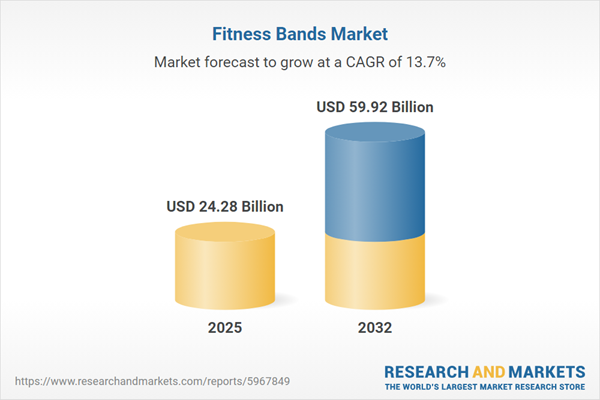Speak directly to the analyst to clarify any post sales queries you may have.
The fitness bands market is experiencing substantial transformation, driven by technological advancements, shifting consumer demands, and evolving regulatory landscapes. Senior decision-makers require clear insights to navigate this competitive ecosystem and capture new opportunities.
Market Snapshot: Fitness Bands Market Size and Growth
The fitness bands market grew from USD 21.39 billion in 2024 to USD 24.28 billion in 2025. It is expected to continue growing at a CAGR of 13.74%, reaching USD 59.92 billion by 2032. This strong outlook signals expanding adoption across both consumer and professional applications, underscored by rising health awareness, corporate wellness initiatives, and technological integration within broader digital health ecosystems.
Scope & Segmentation of the Fitness Bands Market
This report provides comprehensive analysis of the fitness bands market across vital dimensions:
- Product Type: Chest strap monitors, clip-on monitors, and wristband monitors, each serving unique user groups and operational demands.
- Distribution Channel: Direct sales, online retail, and specialty stores, reflecting evolving purchasing behaviors and opportunities for targeted engagement.
- Application: Health & wellness, medical & research, and sports & fitness, highlighting the breadth of end-user adoption from consumers to clinical and athletic arenas.
- Connectivity: Bluetooth and Wi-Fi standards, enabling seamless data transmission between devices and cloud-based platforms.
- Price Range: Economy, luxury, mid-range, and premium segments, addressing diverse budget considerations and feature priorities.
- End User: Adults seeking wellness insights, kids engaging in gamified fitness, and seniors requiring advanced safety and monitoring features.
- Geographies: Americas (including North America and Latin America), Europe, Middle East & Africa, and Asia-Pacific, each featuring distinct adoption drivers and regulatory conditions.
- Leading Companies: Industry stakeholders such as Xiaomi Corporation, Apple Inc., Huawei Investment & Holding Co., Ltd, Alphabet Inc., Samsung Electronics Co., Ltd, Garmin Ltd., Huami Technology Co., Ltd, Lenovo Group Ltd., Sony Group Corporation, and Fossil Group, Inc.
Key Takeaways: Strategic Insights for the Fitness Bands Market
- Success in the fitness bands market depends on continuous sensor innovation, AI-driven features, and user-centric design principles, which unlock expanded functionality and improve engagement.
- Partnerships with healthcare providers, insurers, and software developers are reshaping competitive dynamics by enabling clinical validation, integrated wellness services, and access to subscription-based revenue streams.
- Demand for modularity, data privacy, and interoperability is influencing product architecture and strategic roadmaps as customers seek flexibility and trust in their devices.
- Regional nuances—from health policy to economic conditions—require tailored strategies in product features, price positioning, and distribution to maximize reach and regulatory compliance.
- Customer profiles range from corporate users introducing devices into employee wellness programs, to individual athletes and healthcare providers seeking granular monitoring and early intervention applications.
- Brands balancing global capabilities with regional execution can differentiate through open ecosystems, localized expertise, and innovative retail experiences.
Tariff Impact: Navigating U.S. Electronic Component Tariffs
The introduction of tariffs by the United States in 2025 on imported electronic components significantly influenced global supply chains for fitness bands. Manufacturers responded with diversified sourcing strategies, including nearshoring production and optimizing supply chain resilience, while managing cost pressures through workflow optimization and adjusted pricing strategies. These measures highlight the market’s need for operational agility and transparent sourcing to ensure long-term stability in a fluctuating trade environment.
Methodology & Data Sources
This report utilizes a multi-phased research methodology combining primary and secondary data. Analysts conducted interviews with executives, suppliers, and end users, and systematically reviewed technical papers, regulatory documents, and corporate filings. Quantitative and qualitative findings were harmonized via data triangulation and expert validation to ensure sound conclusions.
Why This Report Matters for Senior Decision-Makers
- Strategic clarity: Support decision-making with trends analysis, competitive benchmarking, and actionable recommendations specific to the fitness bands market.
- Risk mitigation: Unpack supply chain and regulatory risks to better navigate evolving trade measures and regional compliance needs.
- Growth targeting: Identify opportunities for innovation, partnerships, and tailored offerings across diverse consumer segments and expanding application domains.
Conclusion
This executive summary equips leaders with focused intelligence on evolving technologies, supply chain challenges, and segment-specific growth avenues in the fitness bands market. Employ these insights to strengthen strategy, optimize positioning, and drive sustained business value.
Additional Product Information:
- Purchase of this report includes 1 year online access with quarterly updates.
- This report can be updated on request. Please contact our Customer Experience team using the Ask a Question widget on our website.
Table of Contents
3. Executive Summary
4. Market Overview
7. Cumulative Impact of Artificial Intelligence 2025
Companies Mentioned
The companies profiled in this Fitness Bands market report include:- Xiaomi Corporation
- Apple Inc.
- Huawei Investment & Holding Co., Ltd
- Alphabet Inc.
- Samsung Electronics Co., Ltd
- Garmin Ltd.
- Huami Technology Co., Ltd
- Lenovo Group Ltd.
- Sony Group Corporation
- Fossil Group, Inc.
Table Information
| Report Attribute | Details |
|---|---|
| No. of Pages | 185 |
| Published | October 2025 |
| Forecast Period | 2025 - 2032 |
| Estimated Market Value ( USD | $ 24.28 Billion |
| Forecasted Market Value ( USD | $ 59.92 Billion |
| Compound Annual Growth Rate | 13.7% |
| Regions Covered | Global |
| No. of Companies Mentioned | 11 |






